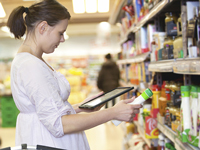DIGITAL SOLUTIONS
SECTION ONE
SECTION TWO
CPG Brands Can Drive Consumer Engagement
Through Augmented Reality
By Dan Zaitsev
Augmented reality is transforming the way we live and interact with the world. It is revolutionizing many industries from retail and CPG to entertainment, printing and advertising.
Many brands consider AR as an innovative technology that can engage customers both online and in store through a mobile device.
In retail, some brands are already embracing AR. They enhance customer in-store experience providing consumers an opportunity to “try on” the goods prior to their purchasing. For instance, people can virtually test out different tones of nail polish color, try on clothes, or get an idea how the furniture will look like inside the house.
The same can work for the CPG industry as well. What if shoppers could walk down the aisles of goods being able to retrieve additional information on products through a mobile device? What if people could find out more about the product by watching a brand video, reading customer reviews and finding coupons? While in store or on the go, it would be more than convenient for shoppers to scan the goods through a mobile device and instantly find appropriate information.
On one hand, AR technology can substantially facilitate the shopper’s life; on the other hand, it enables brands to create engaging AR experiences and bring them to the shoppers.
Here are some of the tools that brands can utilize while building their AR experiences:
Product information: Consumers are demanding greater transparency about the products. The SmartLabel initiative led by the Grocery Manufacturers Association (GMA) aims to supply consumers with detailed product information is becoming the standard for the industry. AR makes it easy to convey product information to consumers, including nutrition facts, calories, fats, etc. This feature can especially be useful to consumers when they look through Free-Standing Inserts (FSIs) and have no product at hand. With one click a shopper can scan the FSI with a product ad and decide whether it fits with a healthy diet or is in line with medical requirements.
Reviews: It is not necessary to browse tons of websites to find customer reviews. AR tools enable to embed reviews from various independent 3rd party providers.
Video: Adding product related commercial video to AR experiences enables brands to increase fan engagement and reward brand loyalty. It is a unique opportunity to convey a special message to potential customers. Video that goes viral can excite the target audience.
Call-to-Action Buttons: CTA buttons allow brands to drive conversations by redirecting users to relevant websites, social networks or phone numbers. For instance, with the ROAR platform (www.theroar.io ) brands can use the buttons like Visit Website, Buy Now, Call us or Like to entice visitors and encourage them to perform a certain action.
Coupons: Brands can take an advantage and show their coupons on mobile to incentivize sales. Based on statistics, 34 percent of respondents cited mobile coupons and deals as one of the most important conveniences of smartphone holiday shopping. In fact, coupons can be one of many CTA buttons. Coupon codes can be embedded into a mobile app and delivered to shoppers via coupon distribution companies.
Cross sales and remarketing: AR can be considered as an additional channel for cross sales. By scanning a specific product, customers will be able to see top-selling product variants. As a result, it might contribute to incremental sales of related goods.
Notifications: Mobile push notifications are a great way for CPG brands to speak directly with a user. With AR, brands can notify potential customers at specific areas where to buy products as well as inform about hot deals and discounts.
Buy online: AR can be used as an additional sales channel providing shoppers with the ability to purchase products online using a smartphone. According to Unbxd, Inc., mobile shoppers in 2016 overtook desktop visitors and reached 61 percent of the total e-commerce traffic. Other research from BI Intelligence suggests that mobile commerce will total 45 percent of total e-commerce and equal $284 billion in sales by 2020. This represents an increase of more than three times as compared to 2016. Apps with augmented reality can be easily integrated into the payment systems of CPG manufacturers or retailers. Thus, by pressing the Buy button, consumers will be able to make a payment in a few clicks.
Nearby stores: By scanning packaged food, potential customers will be able to see nearby local stores where to buy the product and additionally make a price comparison. Consumers can be provided an interactive map with directions how to get there.
Innovate Print Design: With this AR feature, brands can test and play around with product package design before printing and running it into production. By placing the target image directly on the shelves in a retail store, AR technology makes it feasible to see how the package will look like and compare it with competitors.
This list is not comprehensive. There are other useful features that brands can implement depending on their desires and requirements. For food and beverage brands and retailers, AR has a huge potential and allows them to stand out from the competition. No matter how large or small the company is, these tools can allow them to deliver memorable, interactive experiences and engage customers both online and in store. For shoppers, the benefits are obvious - useful information, exciting shopping opportunities and convenience. All that users need is to download an app that supports AR technology.
Dan Zaitsev is the founder and CEO of the ROAR Augmented Reality Platform.
SECTION THREE

